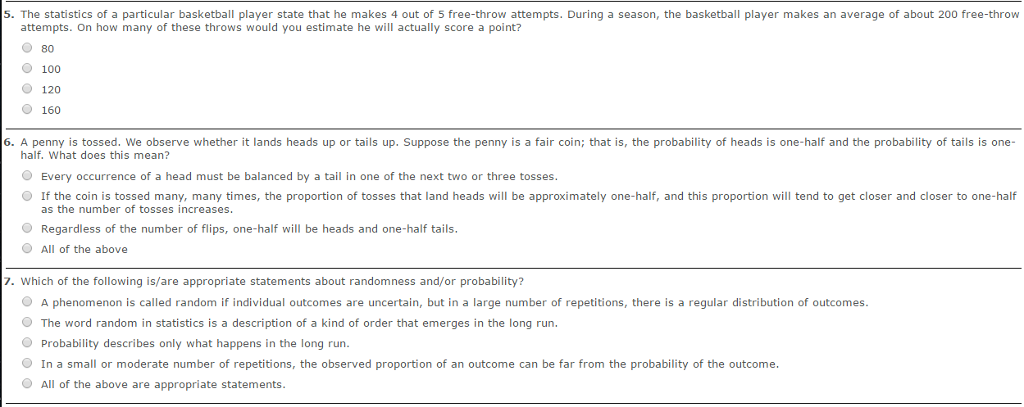Station 1 Craps Statistics Answers
Variables
- Department of Statistics Statistics 403 Instructor: Nicolas Christou Homework 2 EXERCISE 1 Consider the simple regression model y i= 0 + 1x i+ i, with E( i) = 0;var(i) = ˙ 2 and 1;:::; nare independent. It can be shown that the estimators of 1 and 0 are respectively ^ 1 = P i=1 P (x i x )y n i=1 (xi x)2 and ^ 0 = y ^ 1 x. Express ^ 1 = P n.
- 2 HW #44 2, 3, 6 – 8, 13 – 17 7.2 THREE CHILDREN A couple plans to have three children. There are 8 possible arrangements of girls and boys. For example, GGB means the first two children are girls and the third.
- That’s OK – Station 1 Craps Statistics Answers while we’re stuck inside, we suggest you keep up the casino vibe and check out an online casino. No need to sit at your desk or even balance your laptop on your knees.
A variable whose value depends upon a chance experiment is called a random variable. Suppose that a person is asked who that person is closest to: their mother or their father. The random variable of this experiment is the boolean variable whose possibilities are {Mother, Father}. A continuous random variable is a variable whose possible outcomes are part of a continuous data set.
The random variable that represents the height of the next person who walks in the room is a continuous random variable while the random variable that represents the number rolled on a six sided die is not a continuous random variable. A random variable that is not continuous is called a discreet random variable.
Station #1: Craps The Game: Roll a pair of six-sided dice. If the sum is 7 or 11, you win. If the sum is 2, 3, or 12, you lose. If the sum is any other number, you roll again. In fact, you continue throwing the dice until you either roll that number again (WIN!) or roll a 7 (LOSE!). Simulation: Play 30 games of craps with your partner.
Probability Distributions
Example (PageIndex{1})
Suppose we toss two dice. We will make a table of the probabilities for the sum of the dice. The possibilities are:
2,3,4,5,6,7,8,9,10,11,12.
| (x) | 2 | 3 | 4 | 5 | 6 | 7 | 8 | 9 | 10 | 11 | 12 |
|---|---|---|---|---|---|---|---|---|---|---|---|
| (P(x)) | 1/36 | 2/36 | 3/36 | 4/36 | 5/36 | 6/36 | 5/36 | 4/36 | 3/36 | 2/36 | 1/36 |
Exercise (PageIndex{1})
Suppose that you buy a raffle ticket for $5. If 1,000 tickets are sold and there are 10 third place winners of $25, three second place winners of $100 and 1 grand prize winner of $2,000, construct a probability distribution table. Do not forget that if you have the $25 ticket, you will have won $20.
Value (Mean)
Example (PageIndex{2}): Insurance
We when we buy insurance in black jack we lose the insurance bet if the dealer does not have black jack and win twice the bet if the dealer does have black jack. Suppose you have $20 wagered and that you have a king and a 9 and the dealer has an ace. Should you buy insurance for $10?

Solution
We construct a probability distribution table
| (x) | (P(x)) |
| -10 | 34/49 |
| 20 | 15/49 |
(There are 49 cards that haven't been seen and 15 are 10JKQ (jacks, kings and queens) and the other 34 are non tens.)
We define the
expected value = (S times P(x))
We calculate:
[-10(34/49) + 20(15/49) = -40/49 ]
Hence the expected value is negative so that we should not buy insurance. What if I am playing with my wife. My cards are 2 and a 6 and my wife's are 7 and 4. Should I buy insurance? We have:
| (x) | (P(x) |
| -10 | 31/47 |
| 20 | 16/47 |
We calculate:
[-10(31/47) + 20(16/47) = 10/47 = 0.21]
Hence my expected value is positive so that I should buy insurance.
Standard Deviation
We compute the standard deviation for a probability distribution function the same way that we compute the standard deviation for a sample, except that after squaring (x - m), we multiply by (P(x)). Also we do not need to divide by (n - 1).
Consider the second insurance example:
| (x) | (P(x)) | (x - overline{x}) | ( (x - overline{x})^2) |
| -10 | 31/47 | -10.21 | 104 |
| 20 | 16/47 | 19.79 | 392 |
Hence the variance is
[104(31/47) + 392(16/47) = 202 ]
and the standard deviation is the square root of the variance, which is14.2.
Combining Distributions
If we have two distributions with independent random variables (x) and (y) and if (a) and (b) are constants then if
( L = a + bx ) and ( W = ax + by)

then
- (m_L = a + bm)
- (sigma_L^2 = b^2s^2)
- (sigma_L = b , s)
- (m_W = a,m_x + b,m_y )
- (sigma_W^2 = a^2s_1^2 + b^2s_2^2 )
- ( sigma_W = sqrt{a^2, sigma_x^2 + b^2, sigma_y^2})
Example (PageIndex{3})
Gamblers who played both black jack and craps were studied and it was found that the average amount of black playing per weekend was 7 hours with a standard deviation of 3 hours. The average amount of craps play was 4 hour with a standard deviation of 2 hours. What is the mean and standard deviation for the total amount of gaming?
Solution
Here (a) and (b) are 1 and 1. The mean is just
[7 + 4 = 11]
and the standard deviation is just
[ sqrt{3^2 + 2^2} = sqrt{13} ]
Example (PageIndex{4})
If each player spends about $100 per hour on black jack and $200 per hour on craps, what will be the mean and standard deviation for the amount of money that the casino wins per person?
Solution
Here a and b are 100 and 200. The mean is
[100(7) + 200(4) = 1,500]
and the standard deviation is
[ sqrt{(100^2)(3^2)+(200^2)(2^2)}=100sqrt{17}]
Example (PageIndex{5})

If the players spend $150 on the hotel, find the mean and standard deviation of the total amount of money that the players spend.
Here
[ L = 150 + x]
where (x) is the result from part B. Hence the mean is

[ 150 + 1500 = 1,650]
and the standard deviation is the same as part B since the coefficient is 1.
The Binomial Distribution
There is a type of distribution that occurs so frequently that it has a special name. We call a distribution a binomial distribution if all of the following are true
Station 1 Craps Statistics Answers Solver
- There are a fixed number of trials, (n), which are all independent.
- The outcomes are Boolean, such as True or False, yes or no, success or failure.
- The probability of success is the same for each trial.
For a binomial distribution with (n) trials with the probability of success (p) and failure (q), we have
[ P(r text { successes}) = C_{n,r}, p^r ,q^{n-r} ]
Example (PageIndex{6})
Suppose that each time you take a free throw shot, you have a 25% chance of making it. If you take 15 shots, what is the probability of making exactly 5 of them.
Solution
We have ( n = 15 ), ( r = 5), (p = 0.25 ), and (q = 0.75)
Compute
[ C_{15,5}, 0.25^5 ,0.75^{10} = 0.165 ]
There is a 16.5 % chance of making exactly 5 shots.
Example (PageIndex{7})
What is the probability of making fewer than 3 shots?
Solution
Station 1 Craps Statistics Answers Questions
The possible outcomes that will make this happen are 2 shots, 1 shot, and 0 shots. Since these are mutually exclusive, we can add these probabilities.
[ C_{15,2} , 0.25^2, 0.75^{13} + C_{15,1}, 0.25^1, 0.75^{14} + C_{15,0}, 0.25^0 ,0.75^{15} ]
[ = 0.156 + 0.067 + 0.013 = 0.236]
There is a 24 % chance of sinking fewer than 3 shots.
Contributors
- Larry Green (Lake Tahoe Community College)
Station 1 Craps Statistics Answers Questions And Answers
Description
The term “intimate partner violence” includes the following acts as inflicted or caused by a current or former intimate partner:
- Actual or threats of physical violence
- Actual or threats of sexual violence
- Emotional or psychological abuse (e.g., name calling or putdowns, threats to “out” a person’s sexual orientation to family, work or friends)
- Stalking (e.g., excessive calls/texts/emails, monitoring daily activities, using technology to track a person’s location)
- Financial abuse (e.g., withholding money, ruining credit, stopping a partner from getting or keeping a job)
- Threats to “out” a person’s sexual orientation to family, work or friends
Intimate partners can include:
- Current or former spouses
- Boyfriends or girlfriends
- Dating partners
- Sexual partners
Domestic violence can occur in heterosexual and same-sex relationships.
Domestic Violence Statistics and Facts
National Domestic Violence Statistics
Station 1 Craps Statistics Answers Key
- 1 in 4 women and 1 in 7 men will experience severe physical violence by an intimate partner in their lifetime. (CDC, 2017)
- 1 in 10 women in the United States will be raped by an intimate partner in her lifetime. (CDC, 2010)
- Approximately 16.9% of women and 8.0% of men will experience sexual violence other than rape by an intimate partner at some point in their lifetime. (CDC, 2010)
- Data on sexual violence against men may be underreported.
- Approximately 16.9% of women and 8.0% of men will experience sexual violence other than rape by an intimate partner at some point in their lifetime. (CDC, 2010)
- An estimated 9.7% of women and 2.3% of men have been stalked by an intimate partner during their lifetime. (CDC, 2017)
- Nearly half of all women and men in the United States will experience psychological aggression by an intimate partner in their lifetime. (CDC, 2017)
- Over half of female and male victims of rape, physical violence, and/or stalking by an intimate partner experienced some form of intimate partner violence for the first time before 25 years of age. (CDC, 2010)
Domestic Violence Statistics by Race/Ethnicity
- Almost half (47.5%) of American Indian/Alaska Native women, 45.1% of non-Hispanic Black women, 37.3% of non-Hispanic White women, 34.4% of Hispanic women, and 18.3% of Asian-Pacific Islander women experience contact sexual violence, physical violence, and/or stalking by an intimate partner in their lifetime. (CDC, 2017)
Domestic Violence Statistics on Sexual Orientation
- 2 in 5 lesbian women, 3 in 5 bisexual women, and 1 in 3 heterosexual women will experience rape, physical violence, and/or stalking by an intimate partner in their lifetime. (CDC, 2010)
- 1 in 4 gay men, 1 in 3 bisexual men, and 3 in 10 heterosexual men will experience rape, physical violence, and/or stalking by an intimate partner in their lifetime. (CDC, 2010)
Domestic Violence Statistics for New York City
- Intimate partner homicide accounts for over half of all NYC family-related homicides. (NYC DV Fatality Review Committee, 2018)
- The New York City Police Department responds to approximately 230,000 domestic incidents each year. (NYC Mayor’s Office to Combat Domestic Violence)